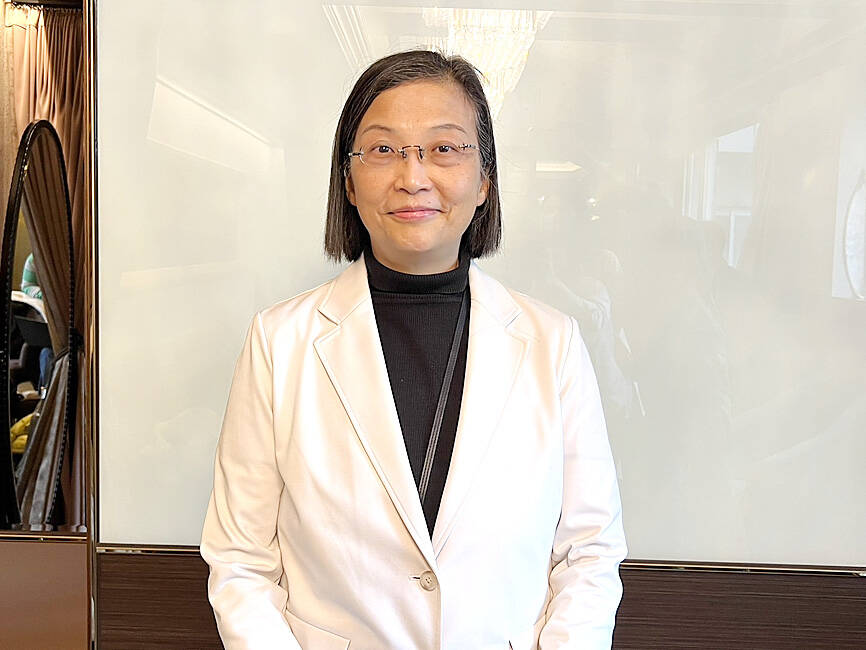GlobalWafers Co (環球晶圓), the world’s third-largest silicon wafer supplier, yesterday said that the financial turmoil in the US and Europe has dimmed the outlook for chip demand in the second half of this year, as growing economic uncertainty could dampen consumer spending.
The Hsinchu-based wafer manufacturer said it is seeing greater pressure from economic uncertainty on the industry’s recovery, as customers would have not expected Silicon Valley Bank, Signature Bank and a tier-one bank like Credit Suisse Group SA to collapse suddenly.
Although the failures are unlikely to cause systemic risks, consumers would be cautious of spending on non-essential items, such as electronics, GlobalWafers said.

Photo: Grace Hung, Taipei Times
“We previously expected that the third quarter would be a better period. However, some customers have turned more conservative due to the spate of financial turmoil. Before that, they were more proactive” about placing orders,” GlobalWafers chairwoman Doris Hsu (徐秀蘭) said on the sidelines of an investors’ conference in Taipei.
Two months ago, GlobalWafers told investors that chip demand would pick up at a marked pace during the second half, as customers’ inventory corrections were expected to bottom out at the end of the second quarter, paving the way for a rebound in end-product demand from the third and fourth quarters.
“We are not saying that market demand will sour in the second half,” Hsu said. “Overall market sentiment turned conservative. At the same time, we also see signs of a positive direction.”
The company signed two new long-term supply agreements in the first quarter, normally a low season, Hsu said.
That indicates some customers remain bullish about chip demand in the long run, she said.
Infineon Technology AG, one of its long-term customers, this week issued a robust business outlook for this year, Hsu said.
Infineon did not ask for a delay in wafer shipments like other customers, given solid demand for power chips, she said.
Texas Instruments Inc also said it might rebuild inventory, as its stocks have dropped to a low level, Hsu said.
Another encouraging sign is that some customers have asked to reduce the number of wafers whose shipments had been delayed, Hsu said.
In addition to strong demand for chips used in autos and industrial devices, GlobalWafers has seen a recovery in demand from display drive IC makers, while demand from memorychip makers remains fragile, she said.
The company’s 8-inch and 12-inch wafer plants continue to operate at a higher utilization rate of at least 95 percent, the company said.
Regarding GlobalWafers’ new 12-inch fab in Texas, Hsu said construction has been proceeding as planned.
The US plant is expected to ramp up production at the beginning of 2025.
Asked if GlobalWafers believes the US’ request to share profits of subsidy applicants based on the Creating Helpful Incentives to Produce Semiconductors (CHIPS) and Science Act is “excessive,” Hsu said the company is categorized as a material company, rather than a foundry company, so the requirements could vary.
The company is closely monitoring when the US would release details about subsidy applications for “Phase 2” companies, she said.

To many, Tatu City on the outskirts of Nairobi looks like a success. The first city entirely built by a private company to be operational in east Africa, with about 25,000 people living and working there, it accounts for about two-thirds of all foreign investment in Kenya. Its low-tax status has attracted more than 100 businesses including Heineken, coffee brand Dormans, and the biggest call-center and cold-chain transport firms in the region. However, to some local politicians, Tatu City has looked more like a target for extortion. A parade of governors have demanded land worth millions of dollars in exchange

Hong Kong authorities ramped up sales of the local dollar as the greenback’s slide threatened the foreign-exchange peg. The Hong Kong Monetary Authority (HKMA) sold a record HK$60.5 billion (US$7.8 billion) of the city’s currency, according to an alert sent on its Bloomberg page yesterday in Asia, after it tested the upper end of its trading band. That added to the HK$56.1 billion of sales versus the greenback since Friday. The rapid intervention signals efforts from the city’s authorities to limit the local currency’s moves within its HK$7.75 to HK$7.85 per US dollar trading band. Heavy sales of the local dollar by

Taiwan Semiconductor Manufacturing Co’s (TSMC, 台積電) revenue jumped 48 percent last month, underscoring how electronics firms scrambled to acquire essential components before global tariffs took effect. The main chipmaker for Apple Inc and Nvidia Corp reported monthly sales of NT$349.6 billion (US$11.6 billion). That compares with the average analysts’ estimate for a 38 percent rise in second-quarter revenue. US President Donald Trump’s trade war is prompting economists to retool GDP forecasts worldwide, casting doubt over the outlook for everything from iPhone demand to computing and datacenter construction. However, TSMC — a barometer for global tech spending given its central role in the

An Indonesian animated movie is smashing regional box office records and could be set for wider success as it prepares to open beyond the Southeast Asian archipelago’s silver screens. Jumbo — a film based on the adventures of main character, Don, a large orphaned Indonesian boy facing bullying at school — last month became the highest-grossing Southeast Asian animated film, raking in more than US$8 million. Released at the end of March to coincide with the Eid holidays after the Islamic fasting month of Ramadan, the movie has hit 8 million ticket sales, the third-highest in Indonesian cinema history, Film